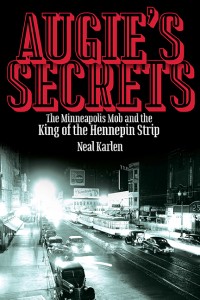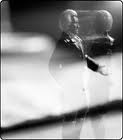What We’re Reading: Augie’s Secrets

 Augie’s Secrets: The Minneapolis Mob and the King of the Hennepin Strip, by Neal Karlen (Minnesota Historical Society Press, 2013)
Augie’s Secrets: The Minneapolis Mob and the King of the Hennepin Strip, by Neal Karlen (Minnesota Historical Society Press, 2013)
St. Paul’s Police Chief John O’Connor protected gangsters during Prohibition. For a small fee, O’Connor looked the other way as long as they left the city before abducting political candidates and burying the evidence. I know this because Neal Karlen knows this. Karlen knows this because his father knows, and his father knows because his uncle, Augie Ratner, was the unofficial mayor of downtown Minneapolis. Through the 1950s, the Jewish mafia ran rackets across the Twin Cities, and Augie was their best friend and confidant. In the loving biography of his faith and family, Augie’s Secrets: The Minneapolis Mob and the King of the Hennepin Strip, Karlen upholds his great uncle’s crown as the King of Hennepin Avenue.
As an adjunct professor with the University of Minnesota, Karlen has written for The New Yorker, GQ and Rolling Stone. Along with writing eight books, Karlen’s also a regular contributor to The New York Times. In 2008, William Morrow published Karlen’s study of the Yiddish language, and this passion for his heritage rings through Augie’s Secrets. Using slang like he’s back at the club, Karlen sometimes can’t slow down to explain what farbisseneh means because he’s telling you about the time boss Davie Berman broke up a pro-Nazi rally at the Minneapolis Elks Lodge.
Augie wasn’t a gangster, but they all came to his club. In the ’30s he opened Augie’s Theatre Lounge on Hennepin, featuring live music and burlesque entertainment. He checked guns at the door, and kept a space in the back lot with a bright light for fighting. Augie knew John Dillinger; they even liked each other. He knew Jimmy Hoffa, Bugsy Segal, and the local boys Isadore “Kid Cann” Blumenfeld, and Davie Berman, who eventually helped Las Vegas become Sin City. Augie gave people a place to hide away from cops, lovers, and debt collectors. Today we know Augie’s as that strip club over on Hennepin, but during the years around Prohibition, with corruption on the streets and in the capital, Augie’s was a haven for people to shed their lies.
As Karlen tells it, Augie knew where the bodies were buried. He knew whose blood stained the money, he knew what the Mayors couldn’t tell the press, and he knew all his neighbors. Every day Augie rode his bicycle around Lake of the Isles while smoking a cigar and waving to families on his way to hear another confession.
Augie played no other angle except that of friendship. He asked only that he be allowed to play the good, always friendly, sometimes buffoonish character he was —but he was aware of everything.
And now we are aware of everything. But when our friend Augie welcomed strangers with a drink and a smile, no one could see his mask. As loyal friend and studious businessman, Augie lived along the line between outlaw and lawman. Hardened by the popular bigotry of Minneapolitans, some of the most powerful Jewish gangsters fought to kill. When the publisher and anti-semite Walter Ligger tried to extort Kid Cann, the Kid gunned him down while unloading the groceries with his family. Karlen found the Kid’s alibi.
Kid Cann said he was “getting a shave and a manicure, just like he did every day, from Dave Garfinkle at Garfinkel’s Artistic Barber Shop, just a few feet away from Augie’s joint. Garfinkle swore it was true. But it wasn’t. At the time of the murder, Dave Garfinkle was cutting Augie’s hair.”
Augie’s Secrets reads like a transcribed monologue, with Karlen acting out all the parts. You open the book and he’s invited you over for drinks to tell you the secrets of his family. In 1943, Augie sat in his club with John Roberts, an FBI special agent, and Bill Stern, the owner of the Dakota National Bank in Fargo and a leader of the Republican National Committee. Also seated was James Francis Keating, one of the most notorious bank robbers of the 1920s. Only Augie knew Keating as Jimmy, the reformed Minnesota man just released from Alcatraz. Karlen recalls his family history with impressive detail:
Augie: Bill, I don’t think you’ve met our friend Jimmy Keating. Jimmy, Billy is a banker in Fargo.
Jimmy: What bank, Bill?
Bill: I’ve owned the Dakota National Bank for many years.
Augie: Jimmy, have you ever done business up there?
Jimmy (pausing): The Dakota National? Oh yes, I know it well.
Jimmy had, in fact, knocked off Bill’s bank a generation before —and gotten away with it. Augie grinned and relit his cigar.
Though his writing captures the danger and excitement of a lawless America, Karlen disturbs the pacified notion of Minnesota’s Nice Culture. Our Twin Cities developed through the post-war boom with pervasive corruption and anti-semitic rage. To read this book is to bear the weight of our shared history. With the rigor of a scholar and the honesty of your closest friend, Karlen challenges us to consider the lives we all carry quietly behind our eyes.
Sometimes you find words that hit you in the gut and fit you like a new pair of glasses. What the last book you read that changed the way you see your city?

 Tall, Slim & Erect: Portraits of the Presidents
Tall, Slim & Erect: Portraits of the Presidents
by Alex Forman
The strain of sourcing information persists throughout art, though most aggressively in the written word. What may be buried as a plagiarized essay in class might be hailed as incisive cultural commentary at the Walker Art Center. Academic writing has secured itself with footnotes, parenthetical references and exhaustive bibliographies to ensure credibility and historical due diligence. A student earns her Ph.D not only by adhering to strict referential guidelines but through innovative and original research, while a mixed media artist could literally steal a loaf of bread and put it on a pedestal. Once in the gallery that bread becomes a bracing critique of federal subsidies, consumer waste and income-inequality. Though the work itself is nothing much, the ready-made, or this ready-stolen, excites us as a concept. In 1967, Sol LeWitt wrote in Artforum, “the idea becomes the machine that makes the art.” The physical talent, that is, the brushstrokes, the bronze-pouring, even ghostwriting, matters far less in some ways than the sketch, the command, the source of inspiration or the name with top billing.
How then do we evaluate material printed at Kinko’s, or sprayed on a wall? If the source remains anonymous, or unvetted, the production becomes dubious. Confronting these tensions of authority, Alex Forman’s fascinating historical aggregate, Tall, Slim & Erect: Portraits of the Presidents, consists entirely of regurgitated information.
As the story goes, Alex Forman found a collection of plastic, full-body portraits of United States Presidents, Washington through Nixon, from the toy maker Louis Marx. Inspired by the crude likenesses and universal height—each standing 60 millimeters short—Forman began her photographic cum biographical exposition, writing along each pictured figurine a brief, colloquial story.
The book is certainly not hers. Here she is not an author, but a shrewd, skilled researcher. Designed in the image of the Jefferson Bible, a self-selected collection of Biblical stories, psalms and passages from various other Bibles, arranged in a certain order of time and subject, Tall Slim & Erect has no page numbers, no quotations, no citations. Forman has compiled a mass of other researchers’ work: with a nine-page bibliography including books by David McCullough and Gore Vidal, biographies published by Simon & Schuster and autobiographies by the presidents themselves, Foreman is certainly well-read, but she also culls from the annals of editorial columns, Wikipedia articles and snopes.com. The reader never knows the truth from the hearsay. Of course, though, Foreman makes no illusions: “None of the text herein was written by me.”
Such a frank, blanket admission leads me to wonder if in fact Forman wrote nothing for this book. If this text is mere paraphrase, or complete plagiarism, what then is Forman’s role? She has become the friend at the bar, the all-too-knowing gossip at work. Each president’s story begins as though someone could say, Did you hear: Thomas Jefferson almost died from rheumatic constipation, he also had boils on his butt; John Adams once called James Monroe a wretched beggar for leaving the presidency with $75,000 of personal debt; when Tyler got the news of his ascension, he was on his knees, shooting marbles with his children.
Forman fills the pages with trivia, and suspiciously accurate numerical data: Taft suffered from sleep apnea; In 1900, FDR didn’t make it the cut for the Harvard football team, so he became a cheerleader; Eisenhower was a licensed pilot, and lived through 7 heart attacks and fourteen cardiac arrests; Johnson is the only person to have held all the non-judicial positions in the American political system. McKinley once shook 1,900 hands in about 19 minutes—Forman does the math for us, about one shake per second.
How can we take all of this seriously? Forman claims that Warren Harding was “superbly handsome,” and died, in 1923, “because it was the best thing to do.” She references diary entries and personal accounts, but can’t help but include absurd, unsupportable claims:
“Jackson was probably the saddest man who ever entered the White House.”
“Benjamin Harrison “was completely honest.”
“Franklin Pierce was the most unambitious man ever to run for office.”
Shot in the arm by an untalented assassin, Garfield died months later due to medical malpractice that morphed his flesh wound into a “twenty-inch-long contaminated gash, stretching from his ribs to his groin.” How does an arm wound become a lacerated torso?
Page by page, Forman’s voice rings with counterfeit scholarship, achieving a fluctuating, unreliable credibility. Her text is less about presidential facts and more about the precedents of authenticity. Though not clearly cited, Forman dutifully lists her references. Though not customarily professional, she and Les Figues Press have designed a book unlike the regimented Academics, a kind that successfully replicated our own untraceable structures of knowledge. This book reveals the wandering ideas that make the machine of history.
The challenge to evaluate the work of art relies on discerning appropriation from inspiration from derivation from impersonation. If I have an idea for a sculpture, but not the capability, I might request, or even pay for someone to make it for me. Where then can we find the work’s source? Surely the worker physically made it, but I envisioned it. It was an idea I had, an idea wrought subconsciously from the deep and fraught network of my surrounding images and voices. Where do I locate the source of my idea, if even I should? Perhaps the origin matters less than what it inspires.





